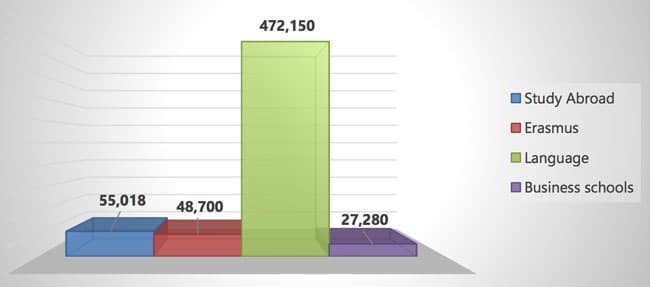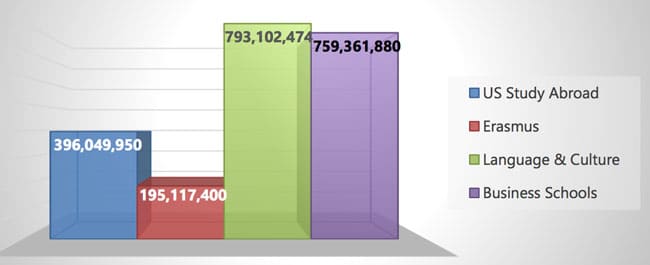Economic impact of foreign students in Spain estimated at €2.2 billion
- A new study estimates total foreign enrolment in Spain at just under 617,000 students in 2018
- The direct economic impact of these exchange, language, and graduate business students has been estimated at nearly €2.2 billion
- The study highlights the economic and cultural importance of international education in Spain, and argues for better data collection and policy development to support further growth in the future
There are nearly 500 million native Spanish speakers worldwide, meaning that Spanish is the second most commonly spoken mother tongue in the world (with only Mandarin able to claim more native speakers). Spanish is also one of the most popular choices for foreign language study (after only English and French) with an estimated 22 million students enrolled in Spanish language studies worldwide in 2018. Given the global importance of Spanish, it is hardly surprising that Spain is one of Europe’s most important study destinations. This is certainly true for language learners but also for exchange students – especially those from the United States – and Spain is a top destination for Erasmus+ exchanges as well. Various education bodies in Spain have sought to measure the economic impact of inbound student mobility over the last decade and more. For the last few years, an annual economic impact report has been produced by the industry consultancy Spain Education Programs with the participation of a consortium of education associations, notably EDUESPAÑA, the Association of North American Programs in Spain (APUNE), the Spanish Association of Business Schools (AEEN), and the Spanish Federation of Associations of Spanish Schools for Foreigners (FEDELE). The national government supports the research effort as well with data and funding from the Spanish Institute for Foreign Trade (ICEX), which operates under The Ministry of Industry, Trade and Tourism. The latest study – The Economic Impact of International Students in Spain, 2018 – was released in April this year. The scope of the analysis has expanded over time and this year’s edition is no exception in that the report now seeks to measure the impact of US exchange students, Erasmus+ exchanges, enrolments in Spanish language studies, and, for the first time, graduate business students. Taking statistics and estimates from across these education sectors, the report counts nearly 617,000 foreign students in Spain in 2018, with a direct economic impact of nearly €2.2 billion (US$2.5 billion). “Spain continues to be an appealing destination for students of all types and the sector has further potential for growth and development,” says the report. “But [Spanish educators and stakeholders] must realize that they are competing with countries around the world for this spend. The relevance of the export of education should be considered when [setting] policies and procedures impacting the industry… Spain is one of the major exporters of education worldwide along with countries greater in size and population, such as The United States, Canada, Australia, and Great Britain. Several of those nations have highly coordinated efforts to build this market and all of them give the sector priority in handling visas, temporary immigration for study, and related governmental support.”
Enrolment by sector
The following chart break downs the study’s total enrolment figure by sector. It should be said that these totals entirely reflect international student head counts, with length of stay varying considerably across these totals.

Economic impact by sector
As these variations suggest, the average language student will typically have a shorter stay, and therefore a lesser economic impact, than will the average business student. The following chart illustrates that impact by sector, and, in so doing, adjusts for the varying lengths of stay for the different categories of students tracked in the SEP analysis.

















